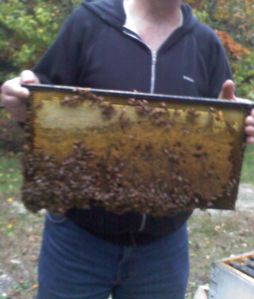Whew! Busy week/weekend folks. Here is the much-anticipated third part to the becoming a backyard beekeeper series!
Thus far we have discussed how to gain knowledge about beekeeping, where to put our hives, and how a network of support could help keep us on the right beekeeping path in part one of the series, and in part two we saw some of the hives there were to choose from.
In this part of the series I’ll be talking about the all important part of actually getting the honeybees!
Having bees to put in a hive would help, now wouldn’t it?
Obtaining and Installing Your Bees
Hiving your first colony of honeybees is an important part of becoming a beekeeper. Like any an expecting parent (except you have about 11,000 “children”coming) it is OK to be a bit apprehensive. You will only need to hive a colony into a particular hive once since bees are perennial and will live in the hive you provide for them for generation from generation. The exception to this, of course is if the colony dies from disease or starvation.
Obtaining the bees
First things first is to determine what race or honeybee you want. There are four major strains of bees and four hybrid races, each with their own pros and cons and different looks as well. However, I only outlined five races that are the most prevalent for beekeepers to buy and those most likely to be encountered. They have their own page here. It is essential that you know which race of honeybee will best suit your style, local environment, and level of beekeeping mastery.
To mail or not to mail
Now that you have had a chance to check out the types of honeybees that are desirable and available, it’s time to choose how to obtain those bees.
There are two ways you can go about buying honeybees: buying them from a commercial supplier, usually from across the country, or find a small deal/supplier around your area (theres usually more beekeepers out there then you know) and buy a Nuc off of them.
A disadvantage to buying bees from a commercial supplier across the country is that the bees need to be shipped across the country in the mail. Believe me the local post office will not like a 3 pound box of buzzing, stressed out bees.
This is why i suggest trying to find a local beekeeper supplier and inquire about their sales of a nuc.
Buying a “Nuc” and installing your girls
Some of you may be asking yourself what a “nuc” is. A nuc, or nucleus is a small wooden or cardboard hive that houses about 3-5 frames of brood and bees, as well as a young queen. All you do to hive in the nuc method is just move the frames of bees and brood into their larger, more permanent home. It’s just that simple. If you use the nuc method of hiving your bees it is a lot less stressful on the bees themselves and is easier than the mail method. Which requires you to shake the box of bees into their new home, all after they have been in the mail for an unspecified amount of time. Personally I bought a nucleus and went to a bee farm to pick it up and they actually switched the frames out for me. I sealed up the exits to my hive and drove the whole thing home. Just like that, nice and easy. When you first install the new colony, you want to leave them alone for about two weeks. Don’t open the hive move the hive bodies around or anything. You could even shove some grass in the entrance to reduce the chance of them coming out prematurely.
I bought my bees from Harvey’s Honey. They have a huge farm in Monroeville, NJ where they sell everything from raw, locally harvested honey, Italian queens, nuc’s, and hive supplies. They are good people and run an honest business, not to mention if you’re almost anywhere in New Jersey and looking for a nuc, then this is the only place to get them!
Here is their phone number (856) 358-1010. And this is their e-mail harvhoney@aol.com.
Well thats it for this edition of “Becoming a Backyard Beekeeper”!
And just a littler reminder, this isn’t an exhaustive list of everything there is to hiving honeybees. Just the methods I know, and have used. As with anything, there is much knowledge to be gained in the pursuit of a hobby or past time. Which is why I always like to stress the importance of taking beekeeping courses from master beekeepers usually at universities and other places of higher knowledge.
So farewell! And keep your ears to the ground for the next post in this series!
Filed under: instructional, Series | Tagged: becoming a beekeeper, bee colony, Harvey's Honey, how to start your own bee hive, italian honeybee, mail order bees, Nuc, nucleus, Start honeybee colony | 2 Comments »







